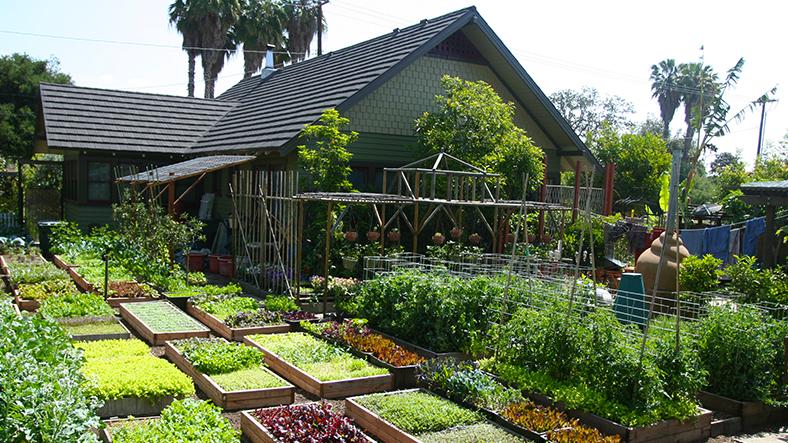The common question gardeners ask is how much of the food we eat as a family can we grow ourselves? This depends on a number of factors, so here are the key things you need to consider. The biggest factor which will determine how much you can grow is how much land do you have? There are many ways to maximize the crops you can grow in any given space, but quite simply, the more land you have, the more crops you can grow. So how much land is enough for a family to grow everything they need for a year.

Research in the 1970’s by John Jeavons and Ecology Action found that 4 thousand square feet of growing space was enough land to sustain one person on a vegetarian diet for a year, with around another 4 thousand square feet usually required for access paths and storage, so that’s a plot 80 feet by 100 feet. How much you can grow in this space will depend on your climate, weather, and soil, and crucially, how much time you have tending to 4 thousand square feet, particularly at the height of the growing season, will take many hours a week of weeding, watering and harvesting. It’s important to choose to grow plants which you already like to eat. There’s little point in growing asparagus if no one in your family likes to eat it. Your grocery bills or a trip to the local farmers market are good places to start.
Create a list of crops and note how much you eat per week. Then multiply that for a whole year’s supply. So for five pounds of potatoes a week, that’s 20 pounds a month 240 pounds a year. So you’ll aim to grow this amount at least with a little more to account for losses due to pests or diseases. For example, how much you want to harvest will dictate how many plants you need to grow and how much space you’ll need to grow them in. Some crops produce many vegetables or fruit per plant, so you’ll need less of these plants to obtain a large harvest.
Others produce one vegetable per plant and require correspondingly more to be sown. Here are our suggestions for some of the most common crops for potatoes.
You’ll want to harvest 75 to 200 pounds per person per year. Each ten foot row will yield ten to 20 pounds, so you’ll need total rows of 75 to 100 feet, which is about 85 plants. For carrots, a harvest of seven to 20 pounds should be enough for one person. A ten foot row will yield seven to ten pounds, so plant total rows of ten to 20 feet, which is about 30 to 60 plants for tomatoes, aim for a harvest of 15 to 65 pounds per person. A ten-foot row will yield 15 to 45 pounds of fruit, so plant total rows of ten to 15 feet, which is about six to ten plants. The Garden Planter works out the row length required for a certain number of plants, so for other crops just continue this process of working out how much you’ll eat. Researching typical yields in your area and working out how many plants you will need.
There are some tried and tested growing techniques which help you to get the most from any garden no matter how big or how small. Where possible plant early, mid and late varieties of your crops. This will help to provide a steady flow of produce throughout the season. It can also help reduce losses due to pests and diseases as your plants will be in different states of growth at different times. So for example, with potatoes you could choose three different varieties, a very early, second early and a main crop variety. Many other crops have seasonal varieties too, including peas, beans, apples, onions and corn.
Succession planting is all about maximizing the space you have available, ensuring that there is always something growing in the ground. So as you harvest your first early potatoes in June, you would then plant a quick growing crop such as some beets. The garden planter can help keep track of this set the dates that crops will be in the ground and select a specific month to see what space might be available. Then pop in a few rows of the succession crop.
Extend your season and protect your crops by using greenhouses, cold frames or a hoop house. In most areas, this will add an extra few weeks at the start and end of the growing season and in cooler climates will ensure you are much more successful with tender crops like tomatoes, cucumbers and melons. That will also help to protect your crops from unseasonable weather and from some pests such as birds, small mammals and deer. Plus it’s always welcome to be able to harvest fresh produce early in the season. Calorie crops are those which have a high calorie content per weight of crop. If you’re growing lots of your own food, you’ll want to include the top five calorie crops, which are potatoes, corn, beans, winter squash, and perhaps grains such as wheat. These crops fill you up, are generally much less work than other crops such as salads or tender crops, and are very versatile. They store well for long periods and are endlessly useful in the kitchen.
Growing any fresh food in your garden is a great way to feed your family. It doesn’t have to be about being totally self-sufficient. Whether you have a few containers by your back door or have a two-acre plot, you’ll be able to add fresh ingredients to your meals and to reduce your grocery bills. And if you garden organically and sustainably, you’ll be reducing your environmental impact too.

